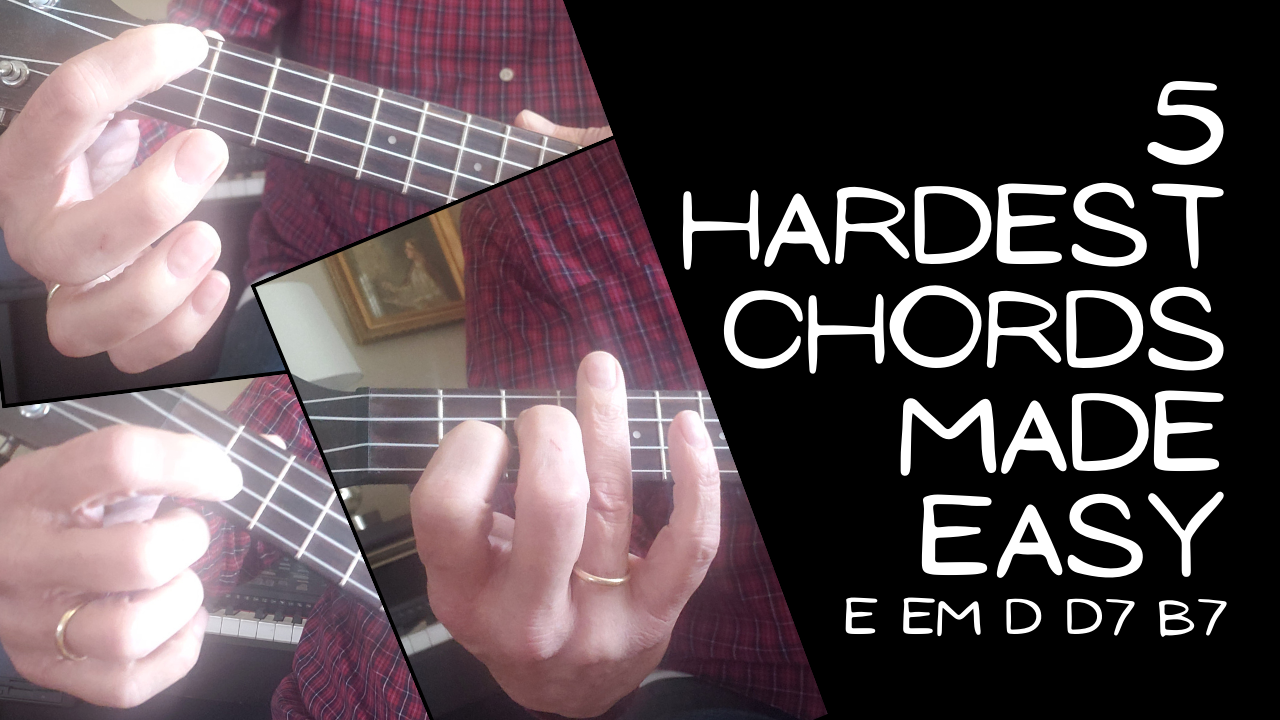Makes chord progressions with these chords much easier...
DISCLOSURE: THIS POST MAY CONTAIN AFFILIATE LINKS, MEANING I GET A COMMISSION IF YOU DECIDE TO MAKE A PURCHASE THROUGH MY LINKS, AT NO COST TO YOU. PLEASE READ MY DISCLOSURE FOR MORE INFO.
You will Learn More and Play More with Play Ukulele NOW.
Find out for yourself why teachers and students have depended on Play Ukulele NOW Methods and Songbooks since 2009
Find out for yourself why teachers and students have depended on Play Ukulele NOW Methods and Songbooks since 2009
Find all my chord related posts here: Chord Tips and Tricks
Here you'll learn lot's of cool stuff from my Ukulele Chord Tricks: Simplify Any Chord book.
Ready to start your 'chord tricks' journey?
Read this first...
These chords either use a different fingering or a muted note to simplify them.
It's important that you realize it's 100% OK to mute a note within a chord - it's not bad, it's not improper technique or a way to avoid the original chord. It's simply a different approach to play the chord.
Chords with muted notes can be found in all styles of music and are actually very common - all the top pros know about and use these... If fact in the 80's when I played guitar professionally one of my favorite chords was a G5: 3X003X (sometimes 3X0033), that could be found in countless popular songs.
This is not just for beginners! Experienced musicians can benefit from these chord forms - they can be used for chord melody, classical or solo arrangements. In fact, the ability to alter and reconfigure chords like this and create these simplified chords is essential to any serious player - that's why I wrote a book about it - Check it out here: Ukulele Chord Tricks: Simplify Any Chord.
More experienced musicians can also use these forms for triads or for, arpeggios or banjo rolls (I cover those in the book too...).
Watch...
THIS ONE FIRST (UPDATE - THIS VIDEO ADDED 2/16/2024): Here's a full length video of all 5:
This is a full length video where I explain these tricks in detail and show you exactly how to play each chord. I also play the chords for you in this video comparing them to the original versions.
In this video there are no explanations like in the one above - just pictures.
In this video it's easy to see the hand positions - watch the whole thing...
Below I walk through each one with notes and additional tips.
The Uke pictured (mines an older version):
Easy E
This is the big one! Everyone wants to know the easy E.
Watch the video first:
NOTES: For this chord we eliminate the repeated note - a major or minor chord is made up for 3 notes so there is always a repeated note (see my free chord book) - it can be eliminated. Just the 3 notes that make up the E major chord are played here.
Here's the Grip: 1X02
The 3rd string is to be muted by touching it with the finger you are using to fret the note on the 4th string (it'll be your 1st finger), you may then strum the chord.
If you choose to play this with arpeggios or banjo rolls - arpeggios and rolls designed for use with 3 note chords can be used - there is an example of that in this video (it's a full length Easy E chord video).
Arpeggios (rolls) for 3 note chords can be found in my Ukulele Chord Tricks: Simplify Any Chord book. A more experienced player may use this chord in that manner.
This chord may even sound better than the more difficult alternative because it may be easier for you to properly fret the notes and there is an open note in the chord.
It may often be a better choice than the more difficult version because it's 'in position' with the other chords as well (I go over 'in position' tricks in the book too).
EX: In a typical E - A - E - B7 progression the Easy E is 'in position' and the more difficult E chord is 'out of position.' play the progression with both and you'll see what I mean. (difficult E: 4442).
There are other difficult E's some of which may be considered easy E's by some folks.
Many musicians would prefer chords in a similar position on the fretboard rather than moving around if they don't have too - it makes for smoother chord changes.
Easy Em
This sounds beautiful as a simplified chord because you have two open notes.
Watch the video first:
NOTES: This is very similar to what we do with the easy E but we mute the note in a different way; you'll simply touch the string with your first finger to mute it (do not press down to fret the note - just touch it). You may then strum the chord.
Grip: 0X02
Since this is another 3 note chord with a muted note, much of what I talked abut with the easy E will apply here as well.
Easy D
For this chord we just use a new fingering to make it easier.
Watch the video first:
NOTES: This fingering should make the D chord easier and playing in the key and D easier as well.
Grip: 2220
With this easy D chord an Em - D progression is a piece if cake - try it.
Easy D7
Say goodbye to barre chords - with the next two chord we simplify some barre chords that are very difficult for beginners.
Watch the video first:
NOTES: This is a D chord without a root note - it's OK - you won't need the root. I talk about 7 chords without root notes and using chords without root notes in my Ukulele Chord Tricks: Simplify Any Chord book.
Grip: 2020
Makes a G - D7 progression sound sound extra beautiful...
Easy B7
Here we are at the final easy chord in this lesson - grab my Ukulele Chord Tricks: Simplify Any Chord book for more - this could be the beginning of your 'chord tricks' journey.
Watch the video first:
NOTES: Like the Easy D7 - it's a 7 chord with no root, here we use the 3rd finger to mute the 4th string.
Grip: X320
What's next?
In my Ukulele Chord Tricks: Simplify Any Chord we learn how to use all of these chords in progressions.
Each PDF comes with a chord progression so you can check out the chord in it's natural habitat...
It's very important to learn chords along with others chords they are typically used with and to learn how to use them in progression (how they work together).
Want more?
Check out my chord related books below. Create beautiful chord progressions in any key and learn to simplify any chord.
Secrets of the Chord Chain: Major and Minor Chord Progressions for the Ukulele
I wish I had books like this when I started playing!
Would have saved me years of frustration.
The great new is you can have them now—In the books I unlock the mysteries of great chord progressions for you and make it so simple to understand that you will be able to create beautiful music right away!
Everything you need to play stunning chord progressions in any key and to fully understand how chord progressions are created and where they come from is here.
Links leads to the books on amazon...
Secrets of the Chord Chain Complete - Major and Minor Chord Progressions for the Ukulele (SAVE WHEN YOU BUY THE COMPLETE EDITION - Books 1 & 2 - 130 pages!)
Ukulele Chord Tricks: Simplify Any Chord
There is! This book will solve all of your chord problems...
Any chord can be simplified - in this book I walk you through how to do it with many tricks that the pros know and use all the time!
Get your paperback on Amazon: Ukulele Chord Tricks - Simplify Any Chord (this leads to the book on amazon and you can preview quite a few pages to check it out)
Get the eBook (instant download): Ukulele Chord Tricks: Simplify Any Chord
Get just one chapter: E Chord and Progression Tricks; E Minor Chord and Progression Tricks; two chapters (they go together): Triads & Accompaniment Patterns Some of these are available FREE to patreon members.
Share this with your ukulele friends - they'll love you for it...














No comments:
Post a Comment